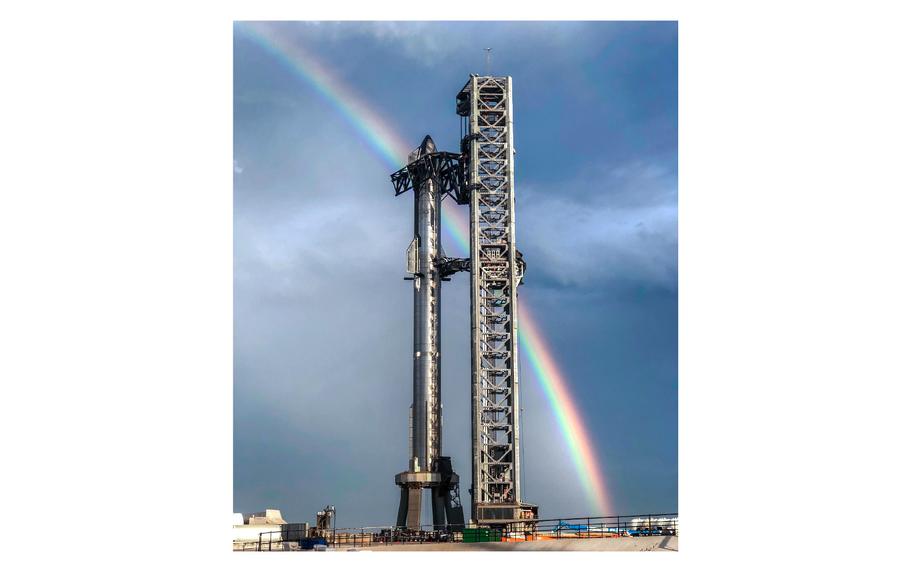
A rainbow forms the backdrop of the Starship rocket system on April 10, 2023. (Flickr/SpaceX)
Elon Musk’s SpaceX is poised to launch its deep-space Starship rocket system Saturday from South Texas for the second time ever, a critical mission roughly seven months after the vehicle’s first major test flight ended explosively in mid-air.
The Starship spacecraft, designed to launch on top of its massive Super Heavy booster, is set for lift-off at 7 a.m. local time from SpaceX’s Starbase launch site in Boca Chica, Texas. The company has a 20-minute launch window on Saturday.
Starship and Super Heavy are supposed to separate a little more than two-and-a-half minutes into flight, sending Starship close to orbit on a nearly full lap around the Earth before it splashes down in the ocean off the coast of Hawaii.
If Starship does successfully reach near-orbital speeds on this go around, it will put SpaceX significantly closer to unlocking the full potential of the monumental vehicle. Starship is the largest and most powerful rocket ever developed, standing at 397 feet (121 meters), 34 feet taller than the Saturn V that sent Neil Armstrong to the moon. It’s designed to carry payloads and people to distant destinations like the moon and Mars, making it central to Musk’s vision of starting a settlement on the Red Planet.
While reaching near orbit on this mission is the ultimate goal, SpaceX doesn’t view in-flight failures as major setbacks, rather considering them to be part of the learning and development process. And it’s very possible this flight could end in another fireball like last time.
“The way we do development is we fly, we break some things, we learn some things, and then we go back and fly again,” William Gerstenmaier, the vice president of build and flight reliability at SpaceX, told Bloomberg News in a recent interview.
Still, there is urgency for SpaceX as it has numerous customers invested in Starship’s success. NASA has shelled out roughly $4 billion to help turn Starship into a lunar lander that will return the space agency’s astronauts to the moon for the first time in more than half a century.
“I will be very pleased when we land on the surface of the moon,” Bill Nelson, the administrator of NASA, told Bloomberg in an interview ahead of the launch. “This is an iterative process. I’m very patient.”
Starship will be responsible for launching the company’s next-generation Starlink satellites, meant to increase capacity of the internet-from-space initiative that SpaceX hopes will generate billions in revenue.
The future of Starship is vital to keeping alive Musk’s goals of reaching Mars and growing his Starlink business. It’s also personally important to Musk, who’s seen his other businesses struggle. Margins are declining at Tesla Inc. and ad revenue is plummeting on X, the social media platform he owns. This week, Musk drew criticism from advertisers and investors over antisemitic content on the platform, including his own posts.
SpaceX has blown past many of its self-imposed deadlines for Starship, making it unclear when the rocket system will be fully operational. And even if this upcoming flight performs flawlessly, SpaceX still has a laundry list of items to accomplish to turn the rocket into the game-changing vehicle that’s been promised. Those items include figuring out life support systems, how to re-fuel Starship in orbit, and how to land the spacecraft on the surface of the moon.
“There’s a lot at stake for the next flight,” Cristina Chaplain, an independent space analyst and former director at the Government Accountability Office overseeing space and defense programs, said. “It’s rocket development. It’s hard. But you need to get that successful orbital test done to move to the next series of tests.”
Less mess
Perhaps SpaceX’s biggest goal is to improve upon its first launch attempt. While the Starship launch system successfully took to the skies for the first time on April 20, multiple engines failed during the climb to space and the full vehicle started spinning out of control, forcing SpaceX to intentionally blow up the rocket. The intensity of Starship’s nearly three-dozen Raptor engines igniting at liftoff also sent chunks of concrete and debris scattered over hundreds of acres of nearby terrain.
To address those problems, SpaceX has made a few tweaks. At the time of Starship and Super Heavy’s separation, the engines on the upper Starship spacecraft are meant to ignite briefly while the Super Heavy booster is still attached, giving the booster a bit of a kick. This newly added technique is known as “hot staging” - and the only way to test it is in flight.
Perhaps the biggest change, however, is to SpaceX’s launchpad. Underneath the rocket’s launch mount, SpaceX added a massive steel plate that gushes large quantities of water during takeoff to absorb and lessen the impact of the vehicle’s Raptor engines, what’s known as a deluge system. That way, fewer chunks of debris go flying.
“We’re just seeing if this thing can work, make it to orbit,” Chaplain said. “But we do want to see that it has addressed these prior issues.”
See more stories like this at bloomberg.com
©2023 Bloomberg L.P.